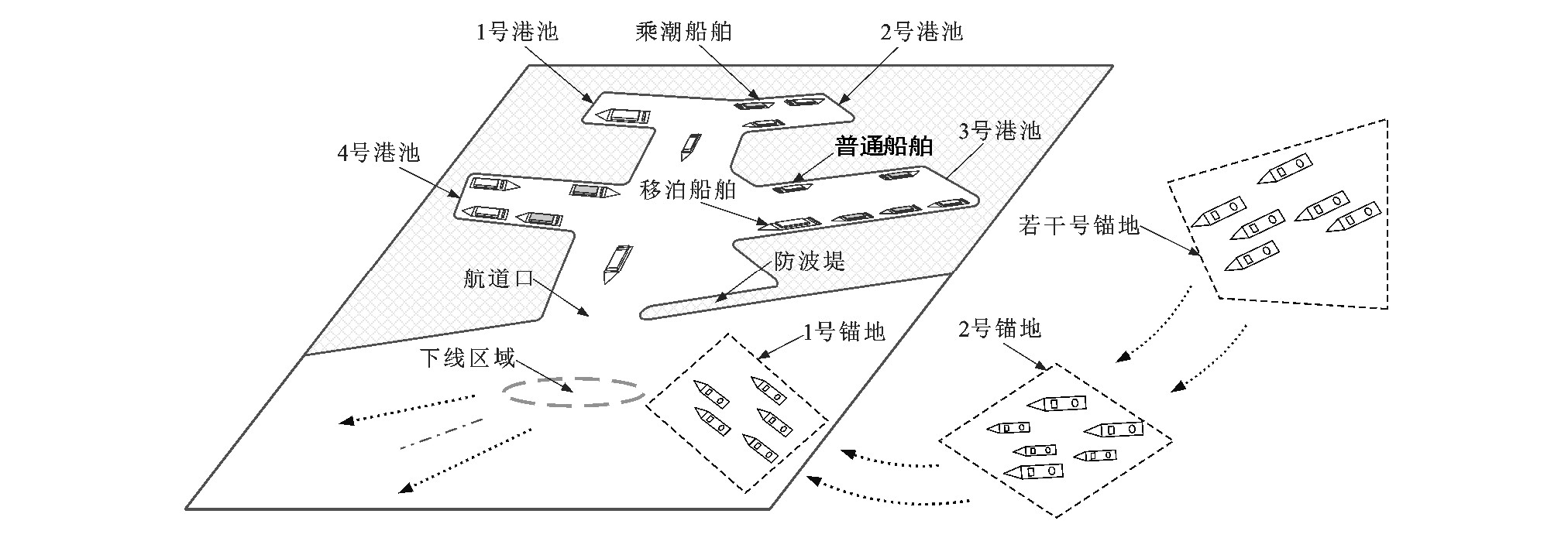Ship scheduling optimization on bulk cargo port considering ship lightening and berth shifting
-
摘要: 为提高散货港口的服务水平, 充分利用现有泊位资源, 研究了采用减载移泊策略的散货港口船舶调度优化问题; 考虑大型船舶减载移泊对散货港口船舶调度的影响, 以船舶进出港次序、移泊次序和移泊位置为决策变量, 以进出港船舶总等待时间最小为目标函数, 构建了混合整数线性规划模型; 基于模型特点设计了混合算法, 给出了生成初始种群的启发式规则, 提出了新种群的邻域构造策略, 并在模拟退火算法中引入有效的改进措施; 为验证方案及其算法的有效性, 对比了基于实际调研资料设计的方案与采用模型和算法优化的方案, 并分析了船舶乘潮比和进出港时段长度对方案优化结果的影响。研究结果表明: 与采用先到先服务思想和贪婪策略的2种现行船舶调度方案相比, 所得方案的平均优化率分别为11.07%和9.84%;船队规模从20艘增加到50艘时, 混合算法的求解耗时均在2min以内, 且所得目标函数值与下界的平均相对偏差为6.92%;随着船舶乘潮比的增加, 方案优化率和目标函数值先呈指数趋势增长, 而后趋于平稳, 乘潮比为50%左右时出现拐点; 随着进出港时段长度的增加, 方案优化率和目标函数值呈“M”形趋势变化, 且在进出港时段长度为130min左右时方案优化效果最为显著, 表明船舶调度优化模型与混合算法可行。Abstract: To improve the service level of bulk cargo port and make full use of its existing berth resource, the ship scheduling optimization on bulk cargo ports using ship lightening and berth shifting strategies was studied.The impact of large ship lightening and berth shifting on ship scheduling in a bulk cargo port was considered, ship inbound/outbound order, berth shifting order and berth shifting position were taken as decision variables, the minimum waiting time of inbound and outbound ships was taken as the objective function, a mixed integer linear programming model was constructed.Based on the characteristics of the model, a hybrid algorithm and heuristic rules for generating an initial population were given.A neighborhood strategy for constructing a new population was proposed, and the effective improvement measures in the simulated annealing algorithm were introduced.To verify the effectiveness of this scheme and the algorithm, the comparison tests for the scheme and algorithm based on actual research data were given, and the influences of ship tidal ratio and length of inbound/outbound period onthe optimization results of the scheme were analyzed.Research result shows that comparing with the two current ship scheduling schemes with the first-come first-served idea and greedy strategy, the average optimization rates of the two proposed schemes are 11.07% and 9.84%, respectively.When the fleet size increases from 20 to 50, the calculation time of the hybrid algorithm always be less than 2 min, and the average relative deviation between the objective function value and lower bound is 6.92%.With the increase in ship tidal ratio, both the optimization rate and objective function value of the scheme increase exponentially at first, and then tend to be stable.The inflection point appears when the tidal ratio is 50%.As the length of inbound/outbound period increases, the scheme optimization rate and target value exhibit an M-shaped trend.The optimization effect is most significant when the length of inbound/outbound period is approximately 130 min.Obviously, the ship scheduling optimization model and the hybrid algorithm are feasible.
-
表 1 不同规模下方案结果对比
Table 1. Comparison of scheme results for different sizes

表 2 各类船舶进出港最小等待时间
Table 2. Minimum waiting times for all kinds of ships inbound and outbound

表 3 不同规模下算法结果对比
Table 3. Comparison of algorithm results for different sizes

-
[1] 代君, 王当利, 刘克中. 基于船舶领域模型的港口受限航道通过能力计算方法[J]. 武汉理工大学学报: 交通科学与工程版, 2009, 33 (4): 679-682. doi: 10.3963/j.issn.1006-2823.2009.04.018DAI Jun, WANG Dang-li, LIU Ke-zhong. Calculation method of restricted waterway transit capacity harbor based on ship domain model[J]. Journal of Wuhan University of Technology: Transportation Science and Engineering, 2009, 33 (4): 679-682. (in Chinese). doi: 10.3963/j.issn.1006-2823.2009.04.018 [2] 刘敬贤, 文元桥. 基于船舶行为特征的港口航道通过能力仿真[J]. 大连海事大学学报, 2009, 35 (2): 31-33. https://www.cnki.com.cn/Article/CJFDTOTAL-DLHS200902008.htmLIU Jing-xian, WEN Yuan-qiao. Simulation of waterway transit capacity at harbor based on the ship behavior[J]. Journal of Dalian Maritime University, 2009, 35 (2): 31-33. (in Chinese). https://www.cnki.com.cn/Article/CJFDTOTAL-DLHS200902008.htm [3] 宋向群, 张静, 郭子坚, 等. 通航历时对沿海散货港区航道通过能力的影响分析[J]. 港工技术, 2010, 47 (2): 18-20. https://www.cnki.com.cn/Article/CJFDTOTAL-GAOG201002007.htmSONG Xiang-qun, ZHANG Jing, GUO Zi-jian, et al. Analysis of navigation duration influence to trafficability of navigation channel in coastal bulk cargo port area[J]. Port Engineering Technology, 2010, 47 (2): 18-20. (in Chinese). https://www.cnki.com.cn/Article/CJFDTOTAL-GAOG201002007.htm [4] 宋向群, 刘佳, 唐国磊. 船舶进出港规则对沿海进口散货港区航道通过能力的影响[J]. 水运工程, 2012 (9): 122-125. https://www.cnki.com.cn/Article/CJFDTOTAL-SYGC201209029.htmSONG Xiang-qun, LIU Jia, TANG Guo-lei. Influence of rules of ship entering and departure on waterway capacity in coastal import bulk port area[J]. Port and Waterway Engineering, 2012 (9): 122-125. (in Chinese). https://www.cnki.com.cn/Article/CJFDTOTAL-SYGC201209029.htm [5] 周鹏飞, 史瑞粉, 魏晓晓. 港区航道系统综合通过能力仿真建模研究[J]. 系统仿真学报, 2013, 25 (6): 1258-1263. https://www.cnki.com.cn/Article/CJFDTOTAL-XTFZ201306020.htmZHOU Peng-fei, SHI Rui-fen, WEI Xiao-xiao. Study on simulation model of synthesis channel transit capacity of port[J]. Journal of System Simulation, 2013, 25 (6): 1258-1263. (in Chinese). https://www.cnki.com.cn/Article/CJFDTOTAL-XTFZ201306020.htm [6] WANG Wen-yuan, TANG Guo-lei, GUO Zi-jian, et al. Study on the impact of inner anchorage on waterway traffic capacity[J]. Applied Mechanics and Materials, 2013, 438/439: 2013-2016. doi: 10.4028/www.scientific.net/AMM.438-439.2013 [7] WANG Wen-yuan, YANG Bin, GUO Zi-jian. Influence of operation days on fairway capacity in coastal bulk cargo port area based on port service level[C]//IEEE. Proceedings of2013IEEE International Conference on Service Operations and Logistics, and Informatics. New York: IEEE, 2013: 287-291. [8] 白响恩, 肖英杰, 孙玉萍, 等. 基于交通波理论的北槽深水航道通航效率[J]. 中国航海, 2014, 37 (1): 61-65. https://www.cnki.com.cn/Article/CJFDTOTAL-ZGHH201401015.htmBAI Xiang-en, XIAO Ying-jie, SUN Yu-ping, et al. Traffic efficiency of north deep-water channel based on traffic wave theory[J]. Navigation of China, 2014, 37 (1): 61-65. (in Chinese). https://www.cnki.com.cn/Article/CJFDTOTAL-ZGHH201401015.htm [9] WANG Wen-yuan, PENG Yun, SONG Xiang-qun, et al. Impact of navigational safety level on seaport fairway capacity[J]. Journal of Navigation, 2015, 68 (6): 1120-1132. doi: 10.1017/S0373463315000387 [10] TANG Guo-lei, WANG Wen-yuan, SONG Xiang-qun, et al. Effect of entrance channel dimensions on berth occupancy of container terminals[J]. Ocean Engineering, 2016, 117: 174-187. doi: 10.1016/j.oceaneng.2016.03.047 [11] KADARSA E, LUBIS H R S, SJAFRUDDIN A, et al. Fairway traffic capacity in Indonesia[J]. Procedia Engineering, 2017, 171: 1443-1453. doi: 10.1016/j.proeng.2017.01.466 [12] WANG Wen-yuan, PENG Yun, TIAN Qi, et al. Key influencing factors on improving the waterway through capacity of coastal ports[J]. Ocean Engineering, 2017, 137: 382-393. [13] FILIPOWICZ W. Vessel traffic control problems[J]. Journal of Navigation, 2004, 57 (1): 15-24. [14] 王中华. 基于遗传算法的港口船舶调度优化问题研究[D]. 上海: 上海海事大学, 2007.WANG Zhong-hua. Study on port ship scheduling optimization based on genetic algorithm[D]. Shanghai: Shanghai Maritime University, 2007. (in Chinese). [15] 徐国裕, 郭涂城, 吴兆麟. 单向水道船舶进出港最佳排序模式[J]. 大连海事大学学报, 2008, 34 (4): 150-153. https://www.cnki.com.cn/Article/CJFDTOTAL-DLHS200804038.htmXU Guo-yu, GUO Tu-cheng, WU Zhao-lin. Optimum scheduling model for ship in/outbound harbor in one-way traffic fairway[J]. Journal of Dalian Maritime University, 2008, 34 (4): 150-153. (in Chinese). https://www.cnki.com.cn/Article/CJFDTOTAL-DLHS200804038.htm [16] SMITH L D, NAUSS R M, CAMPBELL J F, et al. Triangulation of modeling methodologies for strategic decisions in an inland waterway transportation system[C]//IEEE. Proceedings of the 42nd Hawaii International Conference on System Sciences. New York: IEEE, 2009: 1-10. [17] VERSTICHEL J, DE CAUSMAECKER P D, BERGHE G V. Scheduling algorithms for the lock scheduling problem[J]. Procedia—Social and Behavioral Sciences, 2011, 20: 806-815. [18] 王冠儒. 基于遗传算法的VTS船舶调度的设计与实现[D]. 大连: 大连海事大学, 2012.WANG Guan-ru. Design and implementation of ship scheduling in VTS system based on genetic algorithm[D]. Dalian: Dalian Maritime University, 2012. (in Chinese). [19] 张新宇, 郭子坚, 王金涛, 等. 基于航道与泊位资源协调调度的船舶交通优化[J]. 中国航海, 2015, 38 (3): 33-36, 51. https://www.cnki.com.cn/Article/CJFDTOTAL-ZGHH201503009.htmZHANG Xin-yu, GUO Zi-jian, WANG Jin-tao, et al. Optimization of vessel scheduling based on coordination of one-way channel and berths[J]. Navigation of China, 2015, 38 (3): 33-36, 51. (in Chinese). https://www.cnki.com.cn/Article/CJFDTOTAL-ZGHH201503009.htm [20] 柴佳祺, 李锋, 宓为建, 等. 基于启发式算法的散货码头排船问题研究[J]. 中国工程机械学报, 2015, 13 (1): 22-28. https://www.cnki.com.cn/Article/CJFDTOTAL-GCHE201501005.htmCHAI Jia-qi, LI Feng, MI Wei-jian, et al. Heuristicalgorithm-based ship scheduling for bulk terminals[J]. Chinese Journal of Construction Machinery, 2015, 13 (1): 22-28. (in Chinese). https://www.cnki.com.cn/Article/CJFDTOTAL-GCHE201501005.htm [21] 张新宇, 林俊, 郭子坚, 等. 基于模拟退火多种群遗传算法的港口船舶调度优化[J]. 中国航海, 2016, 39 (1): 26-30. https://www.cnki.com.cn/Article/CJFDTOTAL-ZGHH201601007.htmZHANG Xin-yu, LIN Jun, GUO Zi-jian, et al. Vessel scheduling optimization based on simulated annealing and multiple population genetic algorithm[J]. Navigation of China, 2016, 39 (1): 26-30. (in Chinese). https://www.cnki.com.cn/Article/CJFDTOTAL-ZGHH201601007.htm [22] ZHANG Xin-yu, LIN Jun, GUO Zi-jian, et al. Vessel transportation scheduling optimization based on channel berth coordination[J]. Ocean Engineering, 2016, 112: 145-152. [23] LALLA-RUIZ E, SHI X N, VOßS. The waterway ship scheduling problem[J]. Transportation Research Part D: Transport and Environment, 2016, 60: 191-209. [24] QIN Tian-bao, DU Yu-quan, SHA Mei. Evaluating the solution performance of IP and CP for berth allocation with timevarying water depth[J]. Transportation Research Part E: Logistics and Transportation Review, 2016, 87: 167-185. [25] ZHEN L, LIANG Z, ZHUGE D, et al. Daily berth planning in a tidal port with channel flow control[J]. Transportation Research Part B: Methodological, 2017, 106: 193-217. [26] ZHANG J F, SANTOS T A, SOARES C G, et al. Sequential ship traffic scheduling model for restricted two-way waterway transportation[J]. Proceedings of the Institution of Mechanical Engineers Part M: Journal of Engineering for the Maritime Environment, 2017, 231 (1): 86-97. [27] 郑红星, 徐海栋, 刘保利, 等. 单向航道船舶进港次序与泊位分配协同优化[J]. 运筹与管理, 2017, 26 (9): 37-45. https://www.cnki.com.cn/Article/CJFDTOTAL-YCGL201709007.htmZHENG Hong-xing, XU Hai-dong, LIU Bao-li, et al. Oneway channel ship inbound order and berth allocation collaborative optimization[J]. Operations Research and Management Science, 2017, 26 (9): 37-45. (in Chinese). https://www.cnki.com.cn/Article/CJFDTOTAL-YCGL201709007.htm [28] ULUSCUÖS, ÖZBAS B, ALTIOK T, et al. Transit vessel scheduling in the Strait of Istanbul[J]. Journal of Navigation, 2009, 62 (1): 59-77. [29] SLUIMAN F J. Transit vessel scheduling[J]. Naval Research Logistics, 2017, 64 (3): 225-248. [30] 张新宇, 李瑞杰, 林俊, 等. 双向通航港口船舶调度优化模型与算法[J]. 中国航海, 2018, 41 (2): 36-40. https://www.cnki.com.cn/Article/CJFDTOTAL-ZGHH201802008.htmZHANG Xin-yu, LI Rui-jie, LIN Jun, et al. Vessel scheduling optimization in two-way traffic ports[J]. Navigation of China, 2018, 41 (2): 36-40. (in Chinese). https://www.cnki.com.cn/Article/CJFDTOTAL-ZGHH201802008.htm -





 下载:
下载:









